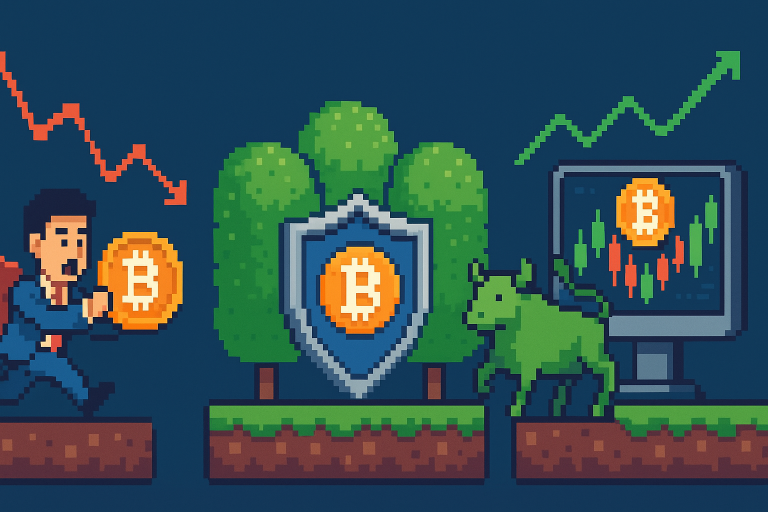Robinhood’s 163% YTD rally to $100 on tokenization hype has pushed the market cap to over $82 billion with a P/E of 47.4x. You’re now paying bubble-era valuations for a firm that just settled $45M in SEC violations while launching fake crypto tokens that even OpenAI disavows.
Executive Summary: The Democratization of Poor Investment Decisions (Now With Wall Street Valuations!)
Robinhood Markets (NASDAQ: HOOD) has transformed from the darling of commission-free trading into a cautionary tale of regulatory recklessness and questionable business practices – and somehow convinced investors to bid the stock up 163% year-to-date, creating an $82+ billion market cap that defies all financial logic. While CEO Vlad Tenev promises to build “the No. 1 global financial ecosystem” through tokenization, investors are now paying a P/E of 47.4x for a company whose core business model faces existential regulatory threats.
The Bottom Line: At $100 per share, $82+ billion market cap, and 47.4x P/E, Robinhood trades at valuations that would make dot-com bubble investors blush – for a company whose main recent innovation is launching misleading financial products while promising blockchain utopia.
The Tokenization Pump: New Buzzword, Wall Street Valuations
The Rally That Defies All Logic
- Current Price: $100 (+163% YTD)
- Market Cap: $82.6 billion
- P/E Ratio: 47.4x (higher than most growth darlings)
- Recent Momentum: +18% in three sessions
- Revenue Multiple: 27x+ trailing revenue
The Absurdity Check: At $82.6 billion for $3 billion in annual revenue, Robinhood trades at a 27.5x revenue multiple. For context, established financial institutions typically trade at 2-5x revenue, and even high-growth SaaS companies rarely sustain 25x+ revenue multiples.
The Wall Street Comparison That Should Terrify Investors
| Company | Market Cap | P/E Ratio | Business Model | Regulatory Risk |
|---|---|---|---|---|
| Robinhood NASDAQ:HOOD | $82.63B | 47.4x | PFOF-dependent | Extreme |
| Charles Schwab NYSE:SCHW | $165.65B | 27.6x | Diversified wealth mgmt | Low |
| Interactive Brokers NASDAQ:IBKR | $98.00B | 32.0x | Established brokerage | Low |
| Goldman Sachs NYSE:GS | $217.17B | 16.0x | Investment banking giant | Low |
| Morgan Stanley NYSE:MS | $225.98B | 16.3x | Wealth & investment mgmt | Low |
| American Express NYSE:AXP | $228.12B | 22.7x | Premium financial services | Low |
The Reality Check: Robinhood trades at a 47.4x P/E while Goldman Sachs – a global investment banking powerhouse with $47+ billion in annual revenue – trades at just 16.0x. You’re paying 3x Goldman’s multiple for a company with 1/15th the revenue and exponentially higher regulatory risk.
What This Means: Interactive Brokers, an established brokerage with proven technology and institutional relationships, trades at $98B market cap (32.0x P/E) with a clean regulatory record. Robinhood, despite its compliance disasters, commands $82.6B (47.4x P/E) based purely on tokenization promises.
Valuation Analysis: When Meme Stocks Meet Wall Street Prices
Current Metrics (Post-Rally):
- Stock Price: $100 (+163% YTD)
- Market Cap: $82.6 billion
- P/E Ratio: 47.4x
- Enterprise Value: ~$78B+
- Revenue Multiple: 27.5x trailing revenue
- EV/EBITDA: 45x+
The Fundamental Disconnect
What $82.6B Represents:
- 27.5x Revenue Multiple (vs. 2-5x typical for financial services)
- 47.4x P/E (vs. 10-20x typical for financials)
- Market Cap per User: $3,177 per customer
- Market Cap per Dollar of Assets: $374 per $1,000 of platform assets
At 47.4x P/E, Robinhood trades at:
- Higher than most dot-com bubble darlings without revolutionary technology
- Premium to established financial giants despite regulatory disasters
- Levels that require perfect execution for years to justify
The Growth Stock Defense vs. Reality
The Bull Case for Growth Premiums: Robinhood defenders argue the valuation premium is justified because it’s a high-growth fintech disrupting traditional finance. Let’s examine this claim:
Growth Metrics (Impressive):
- Revenue Growth: 50% YoY (genuinely strong)
- User Growth: 26M customers (+15% YoY)
- ARPU Growth: +39% YoY to $145
- Platform Assets: $221B (+70% YoY)
Growth Quality Issues (Concerning):
- Market Share: Still only 0.25% of U.S. retail assets despite 26M users
- Customer Retention: Post-GameStop exodus shows fragile loyalty
- Revenue Concentration: 70% from threatened PFOF model
- Geographic Limits: Minimal international presence
The Growth Stock Comparison Problem:
High-Growth SaaS (Typical Multiples):
- Revenue Growth: 40-100%+ annually
- Revenue Multiples: 15-25x (for sustainable models)
- Market TAM: Often trillion-dollar addressable markets
- Competitive Moats: Network effects, switching costs, data advantages
Robinhood’s Growth Profile:
- Revenue Growth: 50% (good but not exceptional)
- Revenue Multiple: 27.5x (higher than most pure SaaS)
- Market TAM: Large but dominated by entrenched players
- Competitive Moats: Questionable – features easily replicated
The Unknown Future Market Reality:
Tokenization Market Size (Robinhood’s Big Bet):
- Current Market: Essentially non-existent for retail equity tokenization
- Projected Growth: Wildly speculative estimates ranging from $1T to $10T by 2030
- Regulatory Framework: Completely uncertain across jurisdictions
- Customer Demand: Unproven outside crypto enthusiasts
- Implementation Timeline: Years away even if everything goes perfectly
Why “Unknown Future Market” Doesn’t Justify Current Valuation:
The Probability Math:
- Scenario 1: Tokenization succeeds massively (20% probability) – maybe current valuation justified
- Scenario 2: Tokenization succeeds moderately (30% probability) – significant overvaluation
- Scenario 3: Tokenization fails or faces regulatory shutdown (50% probability) – massive overvaluation
Expected Value: Even being generous with success probabilities, the risk-adjusted valuation suggests 40-60% overvaluation
Growth Stock Peer Comparison:
- Tesla (2020-2021): 25x revenue at peak, but revolutionizing trillion-dollar auto market
- Zoom (2020): 40x revenue at peak during pandemic demand surge with proven product-market fit
- Snowflake (IPO): 100x+ revenue, but clear path to massive enterprise software TAM
Robinhood’s Growth Story Problems:
- Regulatory Uncertainty: Can’t build unknown future market while core business under attack
- Execution Risk: Track record suggests poor odds of flawless technical execution
- Competition: Established players have more resources for tokenization buildout
- Market Timing: Paying peak valuations for early-stage, unproven market concepts
The Fair Value Analysis for Growth:
- Base Case (Current Business): $15-20B (5-7x revenue for financial services)
- Growth Premium (50% growth): +25-50% = $19-30B
- Tokenization Option Value: +$5-10B (highly speculative)
- Total Fair Value: $24-40B
- Current Valuation: $82.6B
- Overvaluation: 50-70% even accounting for growth premiums
The Scale Problem
At $82.6B market cap for $3B annual revenue, Robinhood would need to:
- Grow revenue 5-10x to justify current multiples at normal financial sector ratios
- Achieve the scale of major investment banks while maintaining growth rates
- Do this despite 0.25% market share and massive regulatory headwinds
Historical Context: Even at the peak of the dot-com bubble, most companies trading at 27x revenue had either massive market opportunities with clear paths to dominance or were generating 100%+ growth rates. Robinhood has neither.
The Math Is Brutal:
- Current Valuation: $82.6B for $3B revenue
- Sustainable Valuation: $15-20B at normal financial multiples (5-7x revenue)
- Downside Risk: 75-80% from current levels
- Upside Scenario: Maybe 10-20% if everything goes perfectly
The Regulatory Nightmare: A $45 Million Settlement Is Just the Beginning
The 2025 SEC Settlement: A Greatest Hits of Compliance Failures
In January 2025, Robinhood agreed to pay $45 million to settle SEC charges involving violations of more than 10 separate securities law provisions:
The Laundry List of Failures:
- Suspicious Activity Reporting: Systematic failures from January 2020 through March 2022
- Identity Theft Protection: Inadequate policies from April 2019 to July 2022
- Cybersecurity Vulnerabilities: Led to unauthorized access affecting millions of customer records
- Recordkeeping Violations: Longstanding failures to maintain electronic communications
- Regulation SHO Violations: Non-compliance with short sale rules from May 2019 through December 2023
The Latest Controversy: OpenAI Tokens and the Trust Deficit
Just when you thought Robinhood had learned its lesson from the GameStop debacle, the company decided to launch “OpenAI tokens” that – plot twist – have absolutely nothing to do with OpenAI.
As of July 3, 2025, both OpenAI and Elon Musk were forced to publicly warn investors that these tokens are “not actual equity stakes” and that OpenAI “did not partner with Robinhood, were not involved in this, and do not endorse it.” Musk’s succinct assessment: “Your ‘equity’ is fake.”
What This Reveals: A company worth $82.6 billion just launched fake equity tokens without basic due diligence. If they can’t properly vet a simple token launch, how will they handle the regulatory complexity of tokenizing actual securities?
Why Compliance Matters More at $82B Valuation
At this market cap, Robinhood now trades alongside financial institutions with:
- Decades of regulatory relationships
- Sophisticated compliance infrastructure
- Crisis-tested management teams
- Diversified revenue models immune to single regulatory changes
The Trust Premium Problem: Goldman Sachs and Morgan Stanley command their valuations partly because regulators and institutional clients trust them. Robinhood’s regulatory track record suggests the opposite – yet investors are paying a premium valuation for a company that can’t execute basic compliance tasks.
The PFOF Existential Threat: 70% of Revenue at Risk in an $82B Company
Payment for Order Flow (PFOF) generates approximately 70% of Robinhood’s revenue. At $82.6B market cap, investors are betting $58B+ on a revenue stream under active regulatory assault.
The Economic Reality at Scale
- Current PFOF Revenue: ~$2.1B annually (70% of total)
- Market Cap Exposure: $58B+ dependent on PFOF continuation
- Regulatory Threat Level: Bipartisan congressional pressure
- European Precedent: PFOF banned entirely
- Peer Comparison: Goldman and Morgan Stanley don’t face single-point-of-failure revenue risks
Why the $82B Scale Makes PFOF Risk Worse
The Mathematics of Dependency:
- Charles Schwab ($165.7B): Diversified across wealth management, banking, trading
- Interactive Brokers ($98.0B): Direct-pay model insulated from PFOF risk
- Robinhood ($82.6B): 70% revenue dependent on one threatened model
If PFOF gets restricted:
- $2.1B annual revenue loss
- $58B+ market cap exposure at current multiples
- 70% revenue hole requiring complete business model reconstruction
- Customer acquisition costs skyrocket without free trading hook
The Competitive Reality: When PFOF disappears, Robinhood must compete against established players on service quality, technology, and trust – precisely where they’re weakest.
Tokenization Strategy: $82B Bet on Unproven Technology
The Vision vs. The $82B Reality
Robinhood’s Tokenization Plan:
- Custom Ethereum Layer 2 blockchain
- 24/7 equity trading via tokenized stocks
- Stablecoin-denominated transactions
- DeFi integration (lending, borrowing, staking)
- Global accessibility through blockchain rails
The $82B Question: Even if tokenization succeeds, does it justify trading at 3x Goldman Sachs’ multiple? Goldman has global reach, established relationships, regulatory credibility, and $47B in annual revenue. Robinhood has tokenization promises and fake OpenAI tokens.
Why Established Players Will Win Tokenization
Goldman Sachs Advantages:
- $217B market cap with proven execution
- Regulatory relationships spanning decades
- Global compliance infrastructure
- Institutional client base ready for tokenized assets
- Technology budget exceeding Robinhood’s entire market cap pre-rally
Morgan Stanley & Charles Schwab:
- Wealth management platforms perfect for tokenized asset integration
- Established custody capabilities
- Trust-based client relationships
- Diversified revenue models reducing execution risk
The Reality: When Goldman Sachs decides to tokenize securities, they’ll do it with regulatory pre-approval, institutional-grade infrastructure, and $47B in annual revenue supporting the investment. Robinhood will still be explaining why they launched fake tokens.
Our Call: The $82 Billion Reality Check
Robinhood at $100 per share and $82.6 billion market cap represents a fundamental misunderstanding of valuation metrics within the financial services sector. You’re paying a 47.4x P/E multiple – nearly 3x what Goldman Sachs commands – for a regulatory pariah whose latest innovation is launching fake equity tokens while promising blockchain revolution.
The Peer Comparison That Says Everything:
- Goldman Sachs: $217B market cap, 16.0x P/E, $47B revenue, global investment banking dominance
- Robinhood: $82.6B market cap, 47.4x P/E, $3B revenue, regulatory disasters and PFOF dependence
The Math That Matters:
- Current Valuation: $82.6B for $3B revenue (27.5x multiple)
- Goldman Efficiency: $217B for $47B revenue (4.6x multiple)
- Sustainable Robinhood: $15-30B at normal financial multiples
- Downside Risk: 60-80% from current levels
Why the Wall Street Comparison Matters
Financial services investors understand quality. They know the difference between:
- Proven franchises (Goldman, Morgan Stanley) with regulatory moats
- Established brokerages (Schwab, Interactive Brokers) with sustainable models
- Experimental platforms (Robinhood) with existential business model risks
At 47.4x P/E, Robinhood trades as if it’s the next J.P. Morgan – but with the compliance record of a startup and the business model sustainability of a meme stock.
The Tokenization Premium Fallacy: Even if Robinhood successfully builds tokenized equity trading, they’re competing against institutions with:
- 10-100x larger balance sheets
- Established regulatory relationships
- Institutional client bases
- Proven crisis management
- Diversified revenue streams reducing execution risk
We recommend STRONG SELL with maximum conviction. The peer comparison makes this obvious: you’re paying premium valuations for inferior business quality, higher regulatory risk, and unproven technology promises.
Position Sizing Recommendations:
- If you own HOOD above $80: Consider immediate profit-taking
- If you’re considering buying at $100: Buy Goldman Sachs at 16x P/E instead
- If you must have fintech exposure: Interactive Brokers offers similar revenue scale with lower risk
Timeline: Wall Street eventually enforces valuation discipline. When institutional investors compare Robinhood’s 47.4x P/E to Goldman’s 16.0x P/E, the reversion will be swift and brutal.
Valuation Takeaways:
This is exactly the kind of valuation dislocation that creates generational wealth transfer – from retail investors chasing tokenization hype to institutional investors who understand that business fundamentals matter more than blockchain buzzwords.
Fair value range: $15-30 (matching Interactive Brokers’ revenue multiple with risk discount)
Peer-relative target: $35-60 (if Robinhood matched Charles Schwab’s execution quality)
Downside target: 60-80% correction to reach sustainable levels
Support levels: $60, then $35, then fundamental value
Timeline: 6-18 months for institutional valuation discipline to assert itself
Disclaimer: This analysis represents our independent research and opinions. When a company with $3B revenue trades at $82.6B market cap while Goldman Sachs generates $47B revenue at $217B market cap, the market is telling you something important about valuation sanity. Sometimes the best risk management is avoiding obviously mispriced assets.


